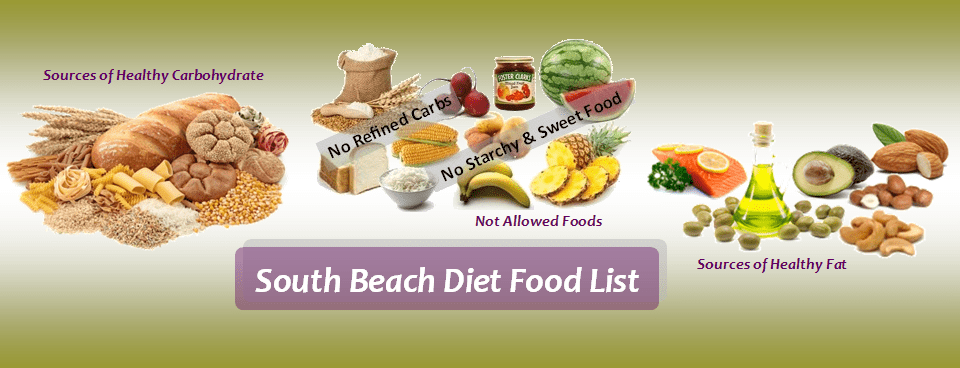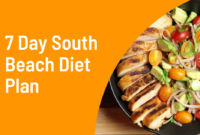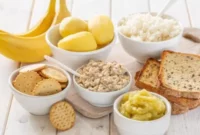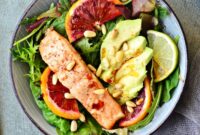South Beach Diet: List of Foods to Eat. This guide delves into the core principles of the South Beach Diet, outlining the foods to embrace and those to avoid across its three phases. We’ll explore the rationale behind the dietary restrictions, providing a clear understanding of why certain foods are encouraged while others are limited. Understanding these guidelines is crucial for successful weight management and improved overall health.
The South Beach Diet differs significantly from many other weight-loss plans by emphasizing the quality of carbohydrates consumed, rather than simply restricting total carbohydrate intake. This approach prioritizes nutrient-rich foods, promoting sustained energy levels and minimizing the blood sugar spikes often associated with rapid weight loss diets. We’ll examine the permitted foods in detail, offering sample meal plans and recipes to make following the diet easier and more enjoyable.
Overview of the South Beach Diet
The South Beach Diet is a popular weight-loss plan that emphasizes healthy eating habits rather than strict calorie restriction. Unlike many diets that severely limit certain food groups, the South Beach Diet focuses on making smart food choices that promote sustained weight loss and improved overall health. It’s structured in phases, each building upon the previous one to establish long-term lifestyle changes.
The core principles of the South Beach Diet revolve around controlling blood sugar levels through the strategic selection of carbohydrates. This approach prioritizes nutrient-rich foods while limiting those that cause rapid spikes in blood sugar, leading to increased fat storage. The diet emphasizes lean protein, healthy fats, and non-starchy vegetables, while limiting processed foods, sugary drinks, and refined carbohydrates. This balanced approach aims to provide sustained energy and curb cravings, fostering a healthier relationship with food.
Phases of the South Beach Diet
The South Beach Diet is divided into three phases, each designed to achieve specific weight-loss goals and establish lasting healthy habits.
- Phase 1: The Induction Phase (Weeks 1-2): This initial phase is the most restrictive, focusing on eliminating foods that cause rapid blood sugar spikes. It emphasizes lean protein, healthy fats, and non-starchy vegetables. Sugary drinks, processed foods, and most fruits are restricted. The goal is to kickstart weight loss and reduce cravings by stabilizing blood sugar levels. This rapid initial weight loss provides motivation and demonstrates the effectiveness of the dietary approach. A typical breakfast might include eggs with spinach and a small amount of avocado, while lunch could consist of grilled chicken salad with a vinaigrette dressing.
- Phase 2: The Weight Loss Phase (Weeks 3-ongoing): This phase gradually reintroduces healthy carbohydrates, such as whole grains and some fruits, while maintaining the emphasis on lean protein and healthy fats. The rate of carbohydrate introduction is carefully monitored, and portions are adjusted based on individual responses. The goal is to continue weight loss at a sustainable pace while expanding dietary options and preventing plateaus. For example, a meal in this phase might include baked salmon with quinoa and steamed broccoli.
- Phase 3: The Lifetime Maintenance Phase: Once the desired weight is reached, this phase focuses on maintaining the weight loss through continued healthy eating habits. This phase allows for more flexibility in food choices, but encourages mindful eating and portion control to prevent weight regain. It emphasizes sustainable lifestyle changes rather than strict adherence to a specific meal plan. This phase includes occasional treats in moderation, maintaining the balanced approach established in the previous phases.
Rationale Behind Dietary Restrictions
The South Beach Diet’s restrictions are based on the understanding of how different foods affect blood sugar levels and insulin response. Rapid spikes in blood sugar, often caused by refined carbohydrates and sugary foods, lead to increased insulin production. High insulin levels promote fat storage, hindering weight loss efforts. By limiting these foods and focusing on foods that cause a slower, more gradual rise in blood sugar, the diet aims to improve insulin sensitivity and reduce fat storage. The emphasis on lean protein and healthy fats helps to maintain satiety, reducing cravings and preventing overeating. The inclusion of non-starchy vegetables provides essential vitamins, minerals, and fiber, supporting overall health and well-being. This approach fosters a balanced and sustainable weight-loss strategy rather than a restrictive, temporary fix.
Final Conclusion
Successfully navigating the South Beach Diet involves understanding the nuances of each phase and making informed food choices. By focusing on nutrient-rich foods, lean protein, and healthy fats, while avoiding processed foods and refined carbohydrates, you can achieve sustainable weight loss and enhance your overall well-being. Remember to consult your physician before starting any new diet plan, especially if you have underlying health conditions. This guide provides a comprehensive framework; personalized guidance from a healthcare professional may be beneficial for optimal results.




